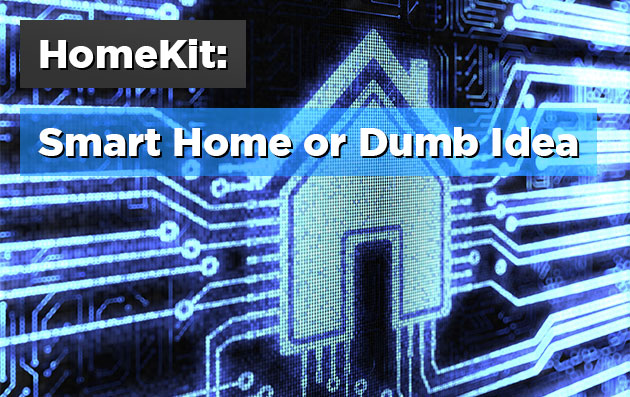
The highlight of this year's WWDC was Apple's new HomeKit. We discuss HomeKit's capabilities, marketability, and everything in between!
Apple’s HomeKit: The Ultimate Convenience or an Orwellian Nightmare?
Though generations of children heard the phrase “goodnight, moon” before bedtime, the next generation of children may be more familiar with “night, night, house,” a command which, spoken into an iPhone, will turn off the lights, adjust the thermostat, and otherwise transform the house into that family’s ideal sleeping environment. Whether you pity or envy a generation of children growing up in smart homes, Apple is working very hard to make it a reality. SLICE discusses the likelihood and implications of a smart future.
Before we predict the future, we must understand 2014. In the last weeks of May, the tech community was abuzz with rumors that Apple had plans to foray into the budding home automation market. Apple’s Senior Vice President of software engineering, Craig Federighi, confirmed these rumors on June 2nd during his keynote address at the company’s Worldwide Developers Conference (WWDC) when he unveiled HomeKit. A feature of the much anticipated iOS 8, HomeKit will allow users to control all smart home appliances and furnishings from a single app. Users will have the option of controlling smart appliances individually or together in groups known as “scenes” and thanks to Siri integration; they need not lift a finger. Just as Apple changed the music industry over a decade ago with iTunes, the company hopes to revolutionize home automation with HomeKit. Apple has teamed with Honeywell, Texas Instruments, and other pioneers in the home automation field to design iOS 8 compatible products.
Obstacles in the Way of the Future
Apple may not be a dark horse, but even the technology titan should expect some bumps in the road on the way to a future populated by smart homes. As is often the case, a huge bump is money. Although the US economy is reportedly improving, it is highly improbable that in the foreseeable future, the average American will have enough disposable income to replace existing, reliable household appliances with brand new, iOS 8 friendly ones.
The average American may not even want to. In a previous blog post, we discussed Internet Explorer’s longstanding popularity despite its many flaws. The web browser’s widespread appeal boils down to its familiarity. For better or worse, humans are creatures of habit, making it likely that many would rather perform the less than convenient task of locking the front door before they leave for work than to learn to program HomeKit to do it for them.
WIFI limitations are yet another obstacle that may prevent Apple’s HomeKit from being met with the initial success the company hopes for. Congestion, which occurs when many people simultaneously attempt to connect their device to the same network, is one of the leading causes of slow Internet. We imagine life would move at a snail’s pace in a home in which everything from the air conditioner to the refrigerator were WIFI dependent.
Is the Smart Home a Dumb Idea?
Assuming Apple clears these hurdles, the future it has primed HomeKit to shape may be more dystopian than utopian. Once the initial thrill of living in an easily altered environment a la Bill Gates wears off, smart home dwellers may realize that luxury can sometimes be more problematic than simplicity.
As fraught as the relationship between man and machine is painted, relations between fellow machines may actually be more complicated. Because WIFI has its limitations, and even an optimal connection cannot prevent one’s iPhone or i0S 8 friendly appliance from experiencing a glitch, it is inevitable that some messages between device and appliance will fail to be relayed. The consequences of these communication failures can range from mild nuisances such as that load of laundry not being dried to risky situations like the front door being left unlocked. Because checking to ensure each message has been sent and received would defeat the purpose of HomeKit, these types of errors are likely to go unnoticed for hours or even days.
Losing a pair of house keys in a public place is stressful. So is losing an iPhone. To lose an iPhone featuring the HomeKit app is to essentially lose both at the same time. If someone were to find said iPhone and outwit its passcode feature (assuming the owner has it enabled in the first place), they would have access to the owner’s contacts, home, and possessions-basically, their entire life- before the owner realized their iPhone was missing. More likely than this scenario is the event of a scorned roommate or ex using HomeKit to exact revenge on the person who remained in the smart home they once shared after the falling out. It is easy to imagine a future episode of Judge Judy focusing on a case of someone messing with their former spouse’s thermostat from a remote location like a bitter ghost.
Even Smarter
In the near future, users may struggle to control their smart home. In the distant future, the smart home may control its owner. Each day, developers are working to make technology more intuitive, bring it closer to reading the user’s mind. It is only a matter of time before technology has a mind of its own. If this mind is an innocent, purely servile mind, this might not be a terrible thing. Humans may live in an easier time, when beds make themselves and mirrors subtly adjust to display a more flattering reflection. However, if it is as complex as the human mind, things will be scary.
The next few years will determine which direction home automation technology takes as well as the role Apple’s HomeKit plays in its journey. In a world of continual change, one thing is certain: SLICE will be there to cover every twist and turn!
